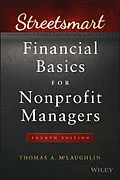The complete guide to the basics of nonprofit financial management
Let's be honest. Most books about financial management are densely written, heavy on jargon, and light on practicality. Expert financial consultant and author Tom McLaughlin takes a different approach with his fourth edition of Streetsmart Financial Basics for Nonprofit Managers. This comprehensive guide provides effective, easy-to-use tips, tools, resources, and analyses.
The light, humorous tone in Streetsmart Financial Basics for Nonprofit Managers makes it an accessible resource for nonprofit executives, board members, students, and those new to the field. This book forgoes useless, pretentious verbiage in order to outline real-world strategies that work. This edition includes:
* New insights, updates, vignettes, case studies, and examples to deal with the implications of nonprofit financial management
* An examination of nonprofit business models in relation to growing demands from the government and other funders
* How to construct business plans for virtually any nonprofit entity
* Customizable resources--including financial worksheets, forms, and Excel templates to help nonprofit managers complete their day to day assignments
* A guided tour through common aspects of nonprofit management, such as financial analysis, accounting, and operations
Practical and informative, Streetsmart Financial Basics for Nonprofit Managers is the go-to financial management reference for nonprofit managers, boards of directors, and funders.
Autorentext
THOMAS A. MCLAUGHLIN is the founder of McLaughlin & Associates, a nonprofit consulting firm. He is a contributing editor for the NonProfit Times, and he taught financial management and strategic management to mission-based MBA and international students at Boston University and Brandeis University for 28 years.
Zusammenfassung
The complete guide to the basics of nonprofit financial management
Let's be honest. Most books about financial management are densely written, heavy on jargon, and light on practicality. Expert financial consultant and author Tom McLaughlin takes a different approach with his fourth edition of Streetsmart Financial Basics for Nonprofit Managers. This comprehensive guide provides effective, easy-to-use tips, tools, resources, and analyses.
The light, humorous tone in Streetsmart Financial Basics for Nonprofit Managers makes it an accessible resource for nonprofit executives, board members, students, and those new to the field. This book forgoes useless, pretentious verbiage in order to outline real-world strategies that work. This edition includes:
- New insights, updates, vignettes, case studies, and examples to deal with the implications of nonprofit financial management
- An examination of nonprofit business models in relation to growing demands from the government and other funders
- How to construct business plans for virtually any nonprofit entity
- Customizable resourcesincluding financial worksheets, forms, and Excel templates to help nonprofit managers complete their day to day assignments
- A guided tour through common aspects of nonprofit management, such as financial analysis, accounting, and operations
Practical and informative, Streetsmart Financial Basics for Nonprofit Managers is the go-to financial management reference for nonprofit managers, boards of directors, and funders.
Inhalt
Preface xiii
Acknowledgments xvii
Note to Reader xix
PART ONE Analysis 1
CHAPTER 1 Structure of Nonprofit Organizations 3
Corporations 3
Programs 6
Hybrid Corporations 8
Loss of Tax-Exempt Status: The Monster Within 14
CHAPTER 2 Mission: Managing Your Two Bottom Lines 17
The Role of a Value System 18
The Nonprofit's Dilemma and How to Solve It 20
CHAPTER 3 Accounting as a Second Language: A Nine-Point Program 23
The Entity Principle 23
Money Measurement 24
Conservatism Principle 24
The Cost Concept 26
The Materiality Principle 27
Going Concern 29
Dual Aspect 30
Realization Principle 32
Matching Principle 33
CHAPTER 4 Assets Are for Boards, Activities Are for Managers 35
Concepts Versus Details 36
Boards Invest, Managers Spend 37
If It Has to Be Decided Today, It's Probably the Wrong Question 38
Boards Own the Controls, Managers Implement Them 38
CHAPTER 5 Balance Sheets: How They Get That Way 39
Current Assets (from IRS Form 990, page 11) 40
Noncurrent Assets 43
Current Liabilities 45
Noncurrent Liabilities 45
Making the Balance Sheet Dance 49
Transparency, Thy Name Is IRS Form 990 52
What to Do 53
CHAPTER 6 Financial Analysis: A Few Analytical Tools 67
Financial Statement Analysis for Math Phobics 68
Current Ratio 75
Days' Cash 77
Days' Receivables 79
Cash Flow to Total Debt 81
Debt to Net Assets 82
Operating Margin 85
Accounting Age of Plant/Equipment (or Land, Buildings, and Equipment) 86
A Footnote 87
CHAPTER 7 Beyond the C3: Alternate Corporate Structures 89
Commonly Available Structures 92
PART TWO Accounting 95
CHAPTER 8 Nonprofit Accounting: Acknowledging the Strings Attached 97
Net Asset Categories 98
Other Provisions 99
What It All Means 99
CHAPTER 9 Cost Accounting: How Much Does It Cost? 103
A Form of Management Accounting 104
Indirect Costs 106
Certain Support Costs Get Assigned to Other Support Costs 106
Breakeven AnalysisAnother Use for Cost Data 110
Cost Accounting versus Cost Reporting 113
CHAPTER 10 Auditing: Choosing and Using an Auditor 115
Audit, Review, and Compilation 117
The Auditor Market 119
Getting Value from the Audit 122
Conclusion 124
PART THREE Operations 125
CHAPTER 11 Cash Is King 127
Up the Balance Sheet 128
How Much Cash Is Enough? 141
Conclusion 145
CHAPTER 12 Capital: Not a Four-Letter Word 147
Sources of Capital 148
The Mechanics of Capital Financing 150
The Present Value of Money 156
The Great Divide among Nonprofits 157
Future Access to Capital Markets 159
The Role of Net Assets 161
Strategic Capital Management 161
CHAPTER 13 Budgeting: Taming the Budget Beast 163
Playing Revenues Like a Symphony 165
Expenses 166
Conclusion 176
CHAPTER 14 Indirect Costs and Other Despised Items 177
Rules Govern Audits, Economics Rules Budgets 179
Still, It's Low That Counts 182
Secrets of the Indirect Cost Game 185
CHAPTER 15 Managing Money-Losing Programs 191
The Origin of the Problem 192
Solutions 192
Other Sources of Value 192
Ding Ding Ding Ding Ding! 194
CHAPTER 16...
